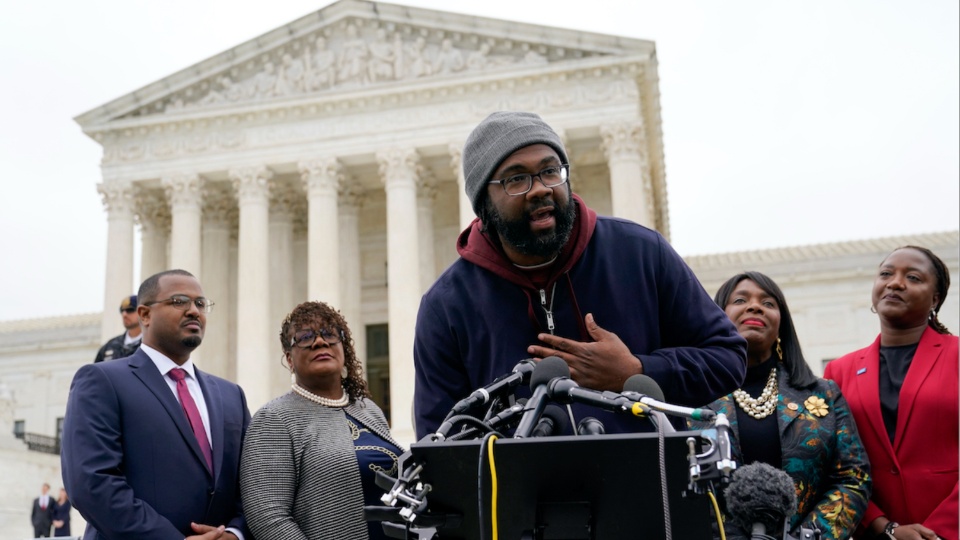
WASHINGTON (AP)—This week’s Supreme Court decision ordering Alabama to redraw its congressional districts was seen by many lawmakers of color and voting rights activists as a stunning victory with the potential to become a major stepping stone for undoing political maps that dilute the strength of communities of color.
Hank Sanders, a former Alabama state lawmaker who has long been politically active in the state, knew there would be a decision since the court heard arguments in the case last fall. He was not anticipating being happy with the outcome, given that previous rulings of the conservative-leaning court had essentially gutted some of its most important provisions.
“I was afraid they were going to go ahead and wipe out section 2,” he said, referring to the part of the Voting Rights Act at stake in the Alabama case.
He was at his law office Thursday in Selma, scene of one of the most pivotal moments in the Civil Rights Movement, when news of the 5-4 ruling in favor of Alabama’s Black voters was announced.
“It was a surprise that was good for my day,” he said.
How the decision will affect similar lawsuits against political maps drawn in other states is unclear, although voting rights groups say the ruling provides firm guidance for lower courts to follow.
The court majority found that Alabama concentrated Black voters in one district, while spreading them out among the others to make it much more difficult to elect more than one candidate of their choice. Alabama’s Black population is large enough and geographically compact enough to create a second district, the judges found. Just one of its seven congressional districts is majority Black, in a state where more than one in four residents is Black.
Similar maps have been drawn in other states, primary by Republican-controlled legislatures.
Kareem Crayton, the Brennan Center’s senior director for voting and representation, called the court’s decision “a welcome surprise” and said challenges to the maps in Louisiana and Georgia were the most similar to the Alabama case.
While it was considering the Alabama case, the Supreme Court had placed a hold on a lower court ruling in Louisiana allowing creation of a second majority-Black district. That’s now likely to be lifted. A federal judge last year also ruled that some of Georgia’s U.S. House and state legislative districts likely violated the Voting Rights Act, but he had allowed the districts to be used in the 2022 elections because it was too close to the election to redraw them.
Maps in all three states could have to be redrawn for the 2024 elections.
Louisiana Gov. John Bel Edwards, a Democrat, said in a statement that the court’s action reaffirmed his own belief that Louisiana’s map, which was drawn by the Republican-controlled Legislature, violated the law.
“As I said when I vetoed it, Louisiana’s current congressional map violates the Voting Rights Act,” he said. “Louisiana’s voting population is one-third Black. We know that in compliance with the principles of the Voting Rights Act, Louisiana can have a congressional map where two of our six districts are majority Black.”
Rep. Troy Carter, a Black Democrat representing Louisiana’s lone district that is majority Black, said the Legislature should immediately convene to draw a second majority-minority district.
“This Supreme Court ruling is a win not just for Alabamians but for Louisianans as well,” Carter said in an emailed statement. “Rarely do we get a second chance to get things right—now Louisiana can.”
In Georgia, Bishop Reginald Jackson, a plaintiff in one of the lawsuits challenging the state’s congressional map, said he was ecstatic when he heard the news about the ruling and hopes it will boost their case.
He said he became involved in the lawsuit amid concerns that the state’s Black population had increased while the number of Black congressional representatives had decreased with the last round of redistricting.
“So how could you have less Black representation when you have more Blacks moving into the state than before?” said Jackson, who presides over 534 African Methodist Episcopal churches in Georgia with over 90,000 parishioners
The Alabama case, along with pending lawsuits in Georgia and Louisiana, means Black voters will likely have an opportunity to elect candidates in three additional districts, said Marina Jenkins, executive director of the National Redistricting Foundation, one of the organizations that has spearheaded voting rights challenges in the states.
She said litigation in Texas by other plaintiff groups could mean additional seats there where minority voters “have the opportunity to elect candidates of their choice that don’t exist now.”
Texas State Rep. Victoria Neave Criado, a Democrat who chairs the Mexican American Legislative Caucus, said the case was a “major win for voting rights.”
She said following recent decisions by the current court in other areas she considers fundamental, such as last year’s overturning of the constitutional right to abortion, she was concerned about the direction the justices would take with voting rights and was relieved to see Thursday’s outcome.
“As we are seeing the Latino community rise in many ways, we want to ensure that Latino power is translated into Latino political power,” Neave Criado said.
Latinos and whites share an equal proportion of the Texas population, about 40% each, according to 2022 Census figures.
Nina Perales, vice-president of litigation with the Mexican American Legal Defense and Educational Fund, said the ruling closes the door on Texas using arguments similar to those made by Alabama as the cases there go forward. Perales leads the litigation for a similar case out of Texas, which is based on the redistricting maps created in 2021.

In addition to the Voting Rights Act challenge to Texas’ congressional districts, similar Section 2 claims have been brought against numerous voting districts used for state legislatures and local governments around the country.
Attorney Mark Gaber argued a case this week alleging Washington’s state legislative districts diluted the voting strength of Hispanic residents and will be arguing a similar case next week involving Native Americans and North Dakota’s state legislative districts. He thinks Thursday’s ruling will strengthen the case.
In Alabama, the question is what happens next. Steve Marshall, the state’s Republican attorney general, said in a statement that he expects to continue defending the challenged map in federal court, including at a full trial.
The Rev. Murphy Green, a resident of Montgomery, said he is just glad to get to the first step with the court decision.
“I was surprised, especially when I think of the makeup of the court,” he said, praising God for sending the Legislature back to “the drawing board and making it mandatory that they create a second Black congressional district.”
He said the five Supreme Court justices in the majority must have looked at the map and the state’s population and decided “it looked ridiculous to those judges, as well.”
Rep. Terri Sewell, the lone Democrat in Alabama’s congressional delegation, said she expects the case will be sent back to the three lower court judges who unanimously agreed the lines drawn by the Legislature likely violated the federal law. Sewell, who is Black, fully expected the new districts to be in place in time for the 2024 elections.
Whatever the process for drawing the new lines, “They’re going to have to follow the ruling of the court,” she said, noting that a revamped congressional map would also mean her district is redrawn.
“It’s a small price to pay to carve up my district in order to be able to have two majority minority districts,” she said.
We hope you appreciated this article. At People’s World, we believe news and information should be free and accessible to all, but we need your help. Our journalism is free of corporate influence and paywalls because we are totally reader-supported. Only you, our readers and supporters, make this possible. If you enjoy reading People’s World and the stories we bring you, please support our work by donating or becoming a monthly sustainer today. Thank you!










